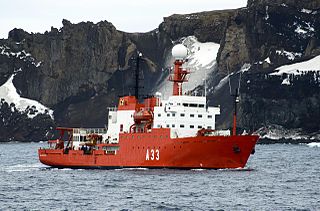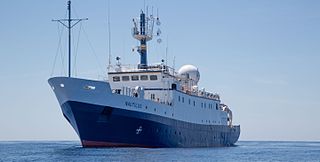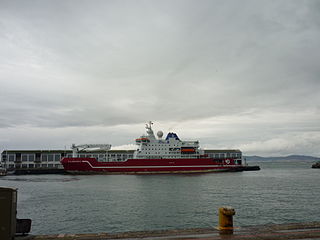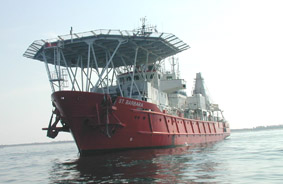 W
WThe research ship had origins in the early voyages of exploration. By the time of James Cook's Endeavour, the essentials of what today we would call a research ship are clearly apparent. In 1766, the Royal Society hired Cook to travel to the Pacific Ocean to observe and record the transit of Venus across the Sun. The Endeavour was a sturdy boat, well designed and equipped for the ordeals she would face, and fitted out with facilities for her research personnel, Joseph Banks. And, as is common with contemporary research vessels, Endeavour carried out more than one kind of research, including comprehensive hydrographic survey work.
 W
WA research vessel is a ship or boat designed, modified, or equipped to carry out research at sea. Research vessels carry out a number of roles. Some of these roles can be combined into a single vessel but others require a dedicated vessel. Due to the demanding nature of the work, research vessels are often constructed around an icebreaker hull, allowing them to operate in polar waters.
 W
WAlliance (A5345) is a Research Vessel owned by NATO and operated by Marina Militare as a NATO Research vessel and owned by the CMRE – Centre for Maritime Research and Experimentation, in La Spezia, Italy. Alliance has the status of an auxiliary ship of the Marina Militare.
 W
WAlpha Crucis is the most recent oceanographic research vessel in Brazil, replacing the older Wladimir Besnard research vessel. It is named after the Alpha Crucis star system that represents São Paulo state in the Brazilian flag. It is 64 metres long and 11 metres wide, and has capacity for 25 researchers and 15 and is capable of remaining 40 days without being resupplied.
 W
WRV Atlantic Explorer is a twin-screw ocean vessel. It is owned and operated by the Bermuda Institute of Ocean Sciences (BIOS) in coordination with and as a part of the University-National Oceanographic Laboratory System (UNOLS) fleet. Atlantic Explorer is in compliance with US Coast Guard, UNOLS and American Bureau of Shipping (ABS) regulations as an uninspected oceanographic research vessel and is supported by the National Science Foundation (NSF). Its homeport is St. George's, Bermuda.
 W
WAurora Borealis is a proposed European research icebreaker, comparable to the world's strongest icebreakers, planned jointly by a consortium of fifteen participant organizations and companies from ten European nations. If built, she would be the largest icebreaker ever built as well as the first icebreaker built to the highest IACS ice class, Polar Class 1.
 W
WThe BAP Carrasco is an oceanographic research vessel of the Peruvian Navy built in 2016 by Freire Shipyard in Vigo (Spain). Its purpose is to perform oceanographic research cruises both, in Peruvian waters and in the Antarctica, in order to fulfil Peru's commitment under the Antarctic Treaty. The ship has polar capability and it is classified with PC7 notation.
 W
WThe Celtic Explorer is a multi-purpose research vessel operated by the Marine Institute in Galway, Ireland. It came into service in 2003 for use in fisheries acoustic research, oceanographic, hydrographic and geological as well as buoy/deep water mooring and ROV Operations. The vessel is 65.5m long and has a capacity to accommodate 35 personnel of which 20-22 can be scientists. The vessel's base is the port of Galway which is located on the west coast of Ireland and offers ready access to the Atlantic Ocean.
 W
WUSNS Chauvenet (T-AGS-29) was an oceanographic survey vessel laid down on 24 May 1967, at Upper Clyde Shipbuilding Corp., Glasgow, Scotland. Launched on 13 May 1968, delivered to the US Navy, 13 November 1970 and placed in service with the Military Sealift Command (MSC) as USNS Chauvenet (T-AGS-29). The ship's namesake is William Chauvenet (1820-1870). He was instrumental in the founding of the United States Naval Academy at Annapolis, MD. The mathematics department of the US Naval Academy in Annapolis was founded by Chauvenet and is housed in Chauvenet Hall.
 W
WCabo de Hornos is a scientific research ship used by the Chilean Navy. Built for oceanographic research. The ship is 74.1 metres long, 19.14 metres wide, and a gross tonnage of 3,068. The ship can carry a complement of 68 people and cruise at 14.6 knots.
 W
WThe Galathea expeditions comprise a series of three Danish ship-based scientific research expeditions in the 19th, 20th and 21st centuries, carried out with material assistance from the Royal Danish Navy and, with regard to the second and third expeditions, under the auspices of the Danish Expedition Foundation. All three expeditions circumnavigated the world from west to east and followed similar routes.
 W
WBIO Hespérides (A-33), is a Spanish polar research vessel. She was built in 1990, by Bazán Shipyards of Cartagena, Spain. Hespérides is used to service the research bases in Antarctica, mainly the Spanish Juan Carlos I Antarctic Base, as well as to perform research voyages. It is operated by the Spanish Navy and the responsible of the scientific equipment is the Spanish National Research Council.
 W
WB.I.C. Humboldt is a Peruvian oceanographic research vessel, with polar capacity, built in 1978, by SIMA shipyard in Callao, Peru, in cooperation with the German Government. The ship has a capacity of 100 people, including crew and scientific staff. The vessel has visited Antarctica on several occasions to assist the Peruvian Antarctic Machu Picchu Base. In 1989 the BIC Humboldt was the subject of a strengthening of the hull and other modifications and improvements after she ran aground off King Georges Island in the Antarctic.
 W
WLeonardo is a NATO Coastal Research Vessel owned by NATO and operated by Marina Militare as Coastal Research vessel (CRV), shared by CMRE - Centre for Maritime Research and Experimentation, in La Spezia Italy.
 W
WExploration Vessel (E/V) Nautilus is a 64-meter American research vessel owned by the Ocean Exploration Trust under the direction of Dr. Robert Ballard, the researcher known for finding the wreck of the Titanic and the German battleship Bismarck. The vessel's home port is at the AltaSea facility in San Pedro, Los Angeles, California, at the Port of Los Angeles. E/V Nautilus is on a global mission of exploration. Nautilus is equipped with a team of remotely operated vehicles (ROVs), Hercules and Argus, a multibeam mapping system, and mapping tools Diana and Echo. All of these tools help the Ocean Exploration Trust conduct deep sea exploration of unknown parts of the ocean to a depth of 4000 meters.
 W
WNorda is a wooden sailing vessel that was commissioned in 1928, originally used as a research vessel in Poland. It served as research vessel, fishing vessel and is now a yacht.
 W
WRV Pelagia is a research vessel in the service of the Royal Netherlands Institute of Sea Research (NIOZ), a research institute of the Netherlands Organisation for Scientific Research.
 W
WTa Kuan (AGS-1601) is a Taiwanese Navy research vessel. Designed to carry out research and surveillance activities, the vessel’s platform was developed from the RV Alliance built for NATO.
 W
WS. A. Agulhas II is a South African icebreaking polar supply and research ship owned by the Department of Environmental Affairs (DEA). She was built in 2012 by STX Finland Rauma shipyard in Rauma, Finland, to replace the ageing S. A. Agulhas, which was retired from Antarctic service in April 2012. Unlike her predecessor, S. A. Agulhas II was designed from the beginning to carry out both scientific research and supply South African research stations in the Antarctic.
 W
WS. A. Agulhas is a South African ice-strengthened training ship and former polar research vessel. She was built by Mitsubishi Heavy Industries in Shimonoseki, Japan, in 1978. S. A. Agulhas was used to service the three South African National Antarctic Programme research bases, Gough Island, Marion Island in the Southern Ocean and SANAE IV in Antarctica, as well as various research voyages.
 W
WRV St. Barbara is a research vessel belonging to the Cypriot Mili Shipping Company, Ltd. Measuring 78.9 m in length with a 13.7 m beam, the St. Barbara is most noted for discovering the 265 meter long wreck of the famed Graf Zeppelin on 12 July 2006 near the port of Łeba. She was last engaged in Geotechnical and exploratory work for the Polish oil company Petrobaltic and is now scheduled to be scrapped in Liepāja where she arrived August 16, 2017.
 W
WA tracking ship, also called a missile range instrumentation ship or range ship, is a ship equipped with antennas and electronics to support the launching and tracking of missiles and rockets. Since many missile ranges launch over ocean areas for safety reasons, range ships are used to extend the range of shore-based tracking facilities.